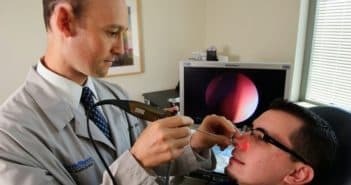
Adenoiditis is a pathological process that is accompanied by inflammation of the pharyngeal tonsils. The main task of tonsils is to provide adequate protection against infections. Doctors call them adenoids. Most often, the disease is diagnosed in small patients aged 3-7 years. Adenoiditis can occur in two forms - acute and chronic.
content
- 1 description and code ICD 10
- 2 Symptoms
- 3 Treatment
- 3.1 adenotomy
- 3.2 Antibacterials
- 3.3 Drops and solutions for washing
- 3.4 Nonconventional means
- 4 point doctor view Kamarouski
description and ICD code 10
Acute adenoiditisIs a disease that predominantly develops in young children, although it can also be diagnosed in adults. There is acute inflammation under the influence of pathogenic viruses or bacteria. Affect the development of the disease can ARD and streptococcal infection.
Also, acute adenoiditis can affect the body of a child who has weakened immunity, after hypothermia, by inhaling harmful substances that are in the atmosphere. The development of the acute form of adenoiditis occurs similarly to the development of angina.
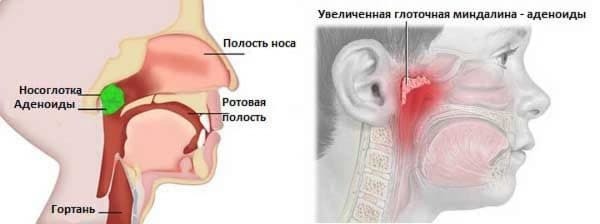
On the photo-acute adenoiditis
According to the ICD 10 adenoiditis has the following designation:
- J35.2 - hypertrophy of adenoids.
- J35.3 - enlargement of tonsils with hypertrophy of adenoids.
- J35.8 - other chronic pathologies of tonsils and adenoids.
Symptoms of
The clinical picture of the pathological process is divided into those that can be seen visually, and those that can be detected only by the doctor when using the instrument.
The visual symptoms of adenoiditis include:
- Difficulties during nose breathing;
- Hearing impairment;
- Isolation of mucus from the nose, which contains pus and a thick consistency;
- The discharge from the nasopharynx drains down the posterior pharyngeal wall, resulting in a productive cough in the child;
- Temperature rise to 37.5 degrees;
- Nasal congestion;
- Nasal head;
- Otitis;
- Headaches;
- Because of the inability to breathe through the nose, the baby's mouth is constantly open;
- Hyperemia of the skin under the nose;
- Persistent infections and colds that have bacterial and viral etiology. This is due to the fact that the airflow penetrates into the lungs through the mouth, therefore, it is not cleaned dry and infected by bacteria and viruses;
- Snoring at night;
- Bad smell from the mouth;
- Restless night's sleep;
- During sleep, the baby opens his mouth.
On video-acute adenoiditis:
Treatment of
Adenoiditis can be treated in two ways - conservative and operative. The first option is prescribed in the case when the disease is normal and there is no significant symptomatology. But the surgical method of therapy is advisable to use when there is a risk of complications, and even if the disease does not lend itself to conservative therapy.
Adenotomy
This manipulation involves the surgical removal of adenoids.
Adenotomy is not recommended for the following reasons:
- Adenoid tissue has the property of growing , so if there is a predisposition to the disease, remission will occur periodically. I'll have to lead the child back to the doctor for a second operation.

In the photo - adenotomy
- Pharyngeal tonsils create a certain barrier , due to which it is possible to prevent the penetration of pathogenic microorganisms. If you delete them, then this function will be lost to the body.
Antibacterial drugs
Antibiotics may be used to treat the disease. Among the most effective are:
- Clacid( can I use Klacid with vasomotor rhinitis, this article will help to understand)

In the photo the drug
- Clasid Amoxicillin( and what is the dosage of Amoxicillin in angina is needed, this article is described)
- Ospen,
- Augmentin,
- Macrolites.
It is advisable to use these antibiotics for acute adenoiditis, which is accompanied by purulent discharge. Parents should not be afraid of this therapy, because today doctors use gentle antibiotics, which do not threaten the health of your child.
Drops and solutions for rinsing
The therapy regimen will necessarily include vasoconstrictor drops. Among the most effective are:
- Nasonex( what is the price of the spray from an allergy to nose Nasonex, indicated in this article)
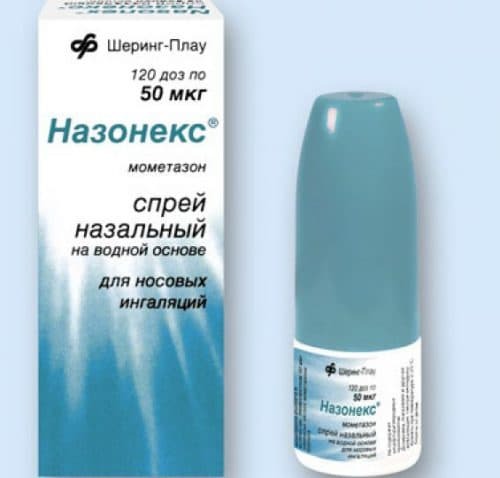
On the photo-nasonex
- Collargol,
- Protargol,
- Polydex( and here's how to use drops in the nose of Polidex for children, narratesin this article)
Thanks to these preparations it is possible to facilitate the breathing of the baby, but only one and the same medication can not be used for 7 days. In addition, dripping drops is after the procedure for washing the nasopharynx has been performed.
In this case, you can use a solution, for the preparation of which take 1 liter of water, 20 g of salt. Draw in the solution with a syringe without needles. Do all the actions 3 times a day.
To relieve nasal breathing, a moist compress on the neck will help. It is necessary to moisten a terry towel in cold water, squeeze it. Collapse 4 times and wrap around the patient's neck. When the towel becomes warm, then remove it. Do this 4-5 times. But the number of procedures will be 2.
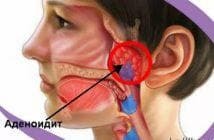 How to use and apply Tonzilotren in adenoids in children will help to understand the content of this article.
How to use and apply Tonzilotren in adenoids in children will help to understand the content of this article.
What to do when a child has adenoids and does not breathe through the nose, and what medications are worth using, will help to understand this article.
What are the symptoms and what can the treatment of adenoiditis in children be described in this article: http: //prolor.ru/n/ bolezni-n /adenoidit/ u-detej-simptomy.html
How is adenoid treatment in children without surgery, and how safe is it to help understand thisinformation.
Nontraditional remedies
People's treatment can be used only in combination with conservative methods. This will ease the child's condition and bring the healing process closer.
Such recipes are considered to be effective:
- Take the leaves of aloe, wring out the juice from them. Connect it in equal quantities with water. Use a solution for gargling twice a day. Also, it can be dripped into the nose 3 drops per pass. But how the aloe vera treats the cold is described in great detail in this article.

On the photo- aloe leaves for the nose
- You can perform inhalations from pine buds, taken in the amount of 20 g. Pour the raw material with 200 ml of hot water, boil for 10 minutes and apply for inhalation of vapors. The duration of the manipulation will be 10 minutes.
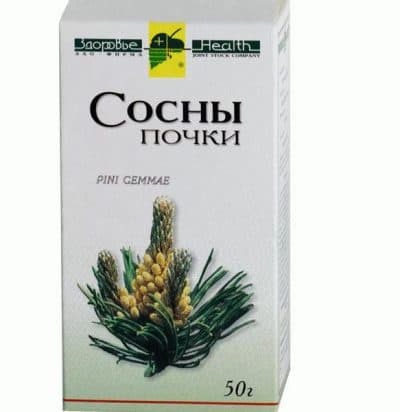
On photo-buds of pine
- For inhalation, 1 kg of sea salt can be used. Heat it in a frying pan, place a couple drops of oil solution of sage and linden. Tilt your head over the frying pan and take a towel. Inhale for 15 minutes.

On the photo-sea salt for inhalation
- Take the leaves of the Kalanchoe, squeeze out the juice and drip it into each nasal passage of 3 drops 3 times a day.
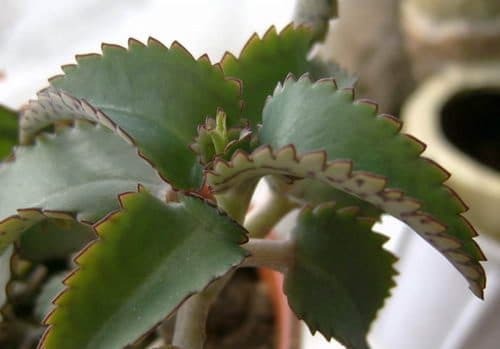
On the photo-leaves of Kalanchoe
- Combine St. John's Wort and butter in the amount of 1: 4. Add 5 drops of herb celandine juice. Apply 2 drops to each nostril for instillation. Duration of treatment will be 10 days.
- Take 200 grams of lard, honey, cocoa and butter. Put everything in a container. Set on fire. Finished tool to put in a glass container, and then add 10 grams in a glass of warm milk and eat overnight.
- To create a compress, you need to take a soft dough, sprinkle it with stems of the plant, the ragwort. The received weight to lay on a neck. Duration of manipulation is 30 minutes.
The view of Dr. Komarovsky
The famous pediatrician Komarovsky believes that the therapy of acute adenoiditis can take place in a homey environment. But only in this case it is necessary to comply with all the prescriptions of the doctor. For the treatment can use a variety of medications, and even folk medicine. At the direction of the otolaryngologist, an individual therapy regimen is prescribed. It determines the doctor taking into account the symptoms, well-being and other features of the body.
Dr. Komarovsky recommends that parents give their consent to an operation to remove adenoids. But it is necessary to perform it in the syndrome of apnea. Then the breathing is slowed down for 5-10 seconds. With such a delay, the child's condition deteriorates sharply. Surgical intervention should be performed with exudative otitis. It can cause a lot of mucus in the middle ear. This leads to hearing loss. The pediatrician Komarovsky advises to carry out treatment of adenoids at formation of jaw strains and at a malignant tumor.
On video-acute adenoiditis in children treatment according to Komarovsky:
Adenoiditis of acute form is a disease that is infectious or bacterial in nature. In children, it manifests itself in the form of unpleasant symptoms, including headache, difficulty in nasal breathing, apnea. With treatment, it is not necessary to delay, otherwise there is a risk of complications and the transition of pathology to a chronic form.
